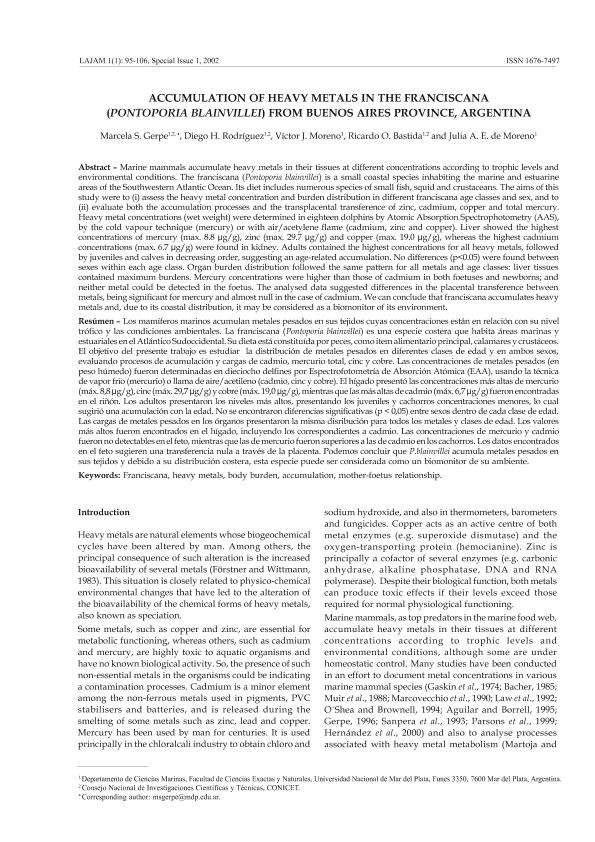Artículo
Accumulation of heavy metals in the franciscana (Pontoporia blainvillei) from Buenos Aires Province, Argentina
Gerpe, Marcela Silvia ; Rodriguez, Diego Horacio
; Rodriguez, Diego Horacio ; Moreno, Victor Jorge; Bastida, Ricardo Oscar
; Moreno, Victor Jorge; Bastida, Ricardo Oscar ; Aizpun, Julia Elena
; Aizpun, Julia Elena
 ; Rodriguez, Diego Horacio
; Rodriguez, Diego Horacio ; Moreno, Victor Jorge; Bastida, Ricardo Oscar
; Moreno, Victor Jorge; Bastida, Ricardo Oscar ; Aizpun, Julia Elena
; Aizpun, Julia Elena
Fecha de publicación:
07/2002
Editorial:
LAJAM
Revista:
Latin American Journal of Aquatic Mammals
ISSN:
1676-7497
Idioma:
Inglés
Tipo de recurso:
Artículo publicado
Clasificación temática:
Resumen
Marine mammals accumulate heavy metals in their tissues at different concentrations according to trophic levels andenvironmental conditions. The franciscana (Pontoporia blainvillei) is a small coastal species inhabiting the marine and estuarineareas of the Southwestern Atlantic Ocean. Its diet includes numerous species of small fish, squid and crustaceans. The aims of thisstudy were to (i) assess the heavy metal concentration and burden distribution in different franciscana age classes and sex, and to(ii) evaluate both the accumulation processes and the transplacental transference of zinc, cadmium, copper and total mercury.Heavy metal concentrations (wet weight) were determined in eighteen dolphins by Atomic Absorption Spectrophotometry (AAS),by the cold vapour technique (mercury) or with air/acetylene flame (cadmium, zinc and copper). Liver showed the highestconcentrations of mercury (max. 8.8 µg/g), zinc (max. 29.7 µg/g) and copper (max. 19.0 µg/g), whereas the highest cadmiumconcentrations (max. 6.7 µg/g) were found in kidney. Adults contained the highest concentrations for all heavy metals, followedby juveniles and calves in decreasing order, suggesting an age-related accumulation. No differences (p<0.05) were found betweensexes within each age class. Organ burden distribution followed the same pattern for all metals and age classes: liver tissuescontained maximum burdens. Mercury concentrations were higher than those of cadmium in both foetuses and newborns; andneither metal could be detected in the foetus. The analysed data suggested differences in the placental transference betweenmetals, being significant for mercury and almost null in the case of cadmium. We can conclude that franciscana accumulates heavymetals and, due to its coastal distribution, it may be considered as a biomonitor of its environment.
Palabras clave:
Franciscana
,
Heavy metals
,
Body burden
,
Accumulation
,
Mother-foetus relationship
Archivos asociados
Licencia
Identificadores
Colecciones
Articulos(CCT - MAR DEL PLATA)
Articulos de CTRO.CIENTIFICO TECNOL.CONICET - MAR DEL PLATA
Articulos de CTRO.CIENTIFICO TECNOL.CONICET - MAR DEL PLATA
Articulos(IIMYC)
Articulos de INSTITUTO DE INVESTIGACIONES MARINAS Y COSTERAS
Articulos de INSTITUTO DE INVESTIGACIONES MARINAS Y COSTERAS
Citación
Gerpe, Marcela Silvia; Rodriguez, Diego Horacio; Moreno, Victor Jorge; Bastida, Ricardo Oscar; Aizpun, Julia Elena; Accumulation of heavy metals in the franciscana (Pontoporia blainvillei) from Buenos Aires Province, Argentina; LAJAM; Latin American Journal of Aquatic Mammals; 1; 1; 7-2002; 95-106
Compartir
Altmétricas



